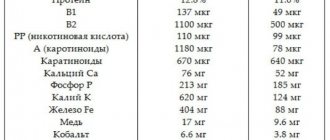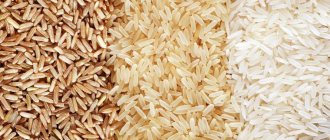Buckwheat is the most commonly used cereal due to its beneficial properties and high nutritional value. The last factor is directly related to calorie content, which varies depending on the method of preparation of the dish. Despite the fact that this figure is high, this product is in demand in weight loss diets. Thanks to slow carbohydrates and easily digestible proteins, buckwheat quickly and for a long time fills you up and energizes you.
Along with this, the body heals. Due to its great benefits and minimum contraindications, cereal is recommended for consumption by people of any age and condition.
- Buckwheat diet
- Casserole
Composition of buckwheat
Most often, buckwheat kernels are used for food - unsteamed and without husks, whole buckwheat grains of a rich brown color. This is the richest product in biochemical composition. It contains:
- starch;
- saturated and unsaturated fatty acids;
- mono- and disaccharides;
- vitamins: groups B, E, A, PP;
- micro- and macroelements: iron, phosphorus, magnesium, potassium, calcium, sodium, sulfur, silicon, iodine, zinc;
- organic acids: oxalic, citric, malic;
- arginine, lysine;
- routine;
- choline;
- folic and nicotinic acid;
- cellulose.
Vitamin and mineral composition of buckwheat
Buckwheat contains the following vitamins:
- Group A;
- Groups B (1;2;6;9);
- E;
- RR.
In addition, it contains microelements such as:
- Calcium;
- Iron;
- Silicon;
- Potassium;
- Magnesium;
- Iodine;
- Phosphorus;
- Sodium and others.
Buckwheat porridge is endowed with a rich and rich composition.
Calories and nutritional value
Buckwheat porridge is ideal for athletes and people watching their figure. Despite its nutritional value, it does not contribute to weight gain. It is a valuable source of vitamins and minerals.
Per 100 grams of dry grain there are 305 kcal with the following distribution of BJU: proteins - 14 g, fats - 4 g, carbohydrates - 60 g.
However, such a high indicator does not interfere with weight loss, since in the finished state the cereal is lower in calories. It’s easy to calculate how many calories are in one serving of buckwheat porridge yourself:
- Take the ratio of kernels and water 1:2 (for example, 100 g per 200 ml).
- After cooking, it swells, resulting in 300 g, while the total calorie content remains unchanged - 305 kcal.
- Divide this value by 3, so the energy value of 100 g is no more than 102 kcal.
The composition contains a predominance of carbohydrates, but they are complex and have a low glycemic index. Therefore, they are not forbidden to use without restrictions. That is why the product is indicated for mono-diets and fasting days.
Calorie content and nutritional value of all types of buckwheat per 100 g serving:
| Cooking method | Number of calories, kcal | Proteins, g | Fats, g | Carbohydrates, g |
| Boiled in water without salt and oil | 100,8 | 4,2 | 1,1 | 18,5 |
| On water, with oil | 137, 4 | 3,5 | 5,7 | 16,8 |
| With salt and butter | 142 | 4 | 2,6 | 16,6 |
| With salt and sunflower oil | 153,7 | 4,8 | 5,2 | 27,4 |
| With milk, no sugar or butter | 117,5 | 6,5 | 4,3 | 17,5 |
| With milk and sugar | 176 | 3,8 | 1,7 | 28,1 |
| With milk and butter | 177 | 6,2 | 7,1 | 21,8 |
| With meat (chicken, beef, turkey) | 117/108,6/105 | 10/6,7/9 | 2,4/4,4/2,8 | 13,8/11,3/11,5 |
| With kefir | 75,6 | 5,3 | 0,8 | 16,2 |
| Steamed | 108,2 | 4 | 1,5 | 20,8 |
Beneficial features
Buckwheat can be a complete substitute for meat, which is explained by its nutritional capabilities. Thanks to its rich chemical composition, it is able to saturate the human body with essential vitamins and microelements. It is recommended to include it in your daily diet to avoid many health problems.
Useful properties of buckwheat:
- Stabilizes blood pressure and hematopoiesis.
- Positively affects the musculoskeletal component.
- Activates the central nervous system and enhances brain activity.
- Serves as protection against malignant neoplasms.
- Prevents the development of cardiovascular diseases, strengthens vascular walls.
- Normalizes digestion: improves intestinal motility, relieves constipation.
- Increases immunity.
- Reduces “bad” cholesterol and hemoglobin levels in the blood.
- Cleanses away impurities and toxins.
- Uplifts your mood and energizes you.
- Helps eliminate swelling and inflammation due to arthrosis, arthritis and rheumatism.
Buckwheat dishes are recommended for constant consumption by children, which contributes to the normal development of the growing body. At the same time, mental abilities improve: concentration and memory. People involved in sports need such a nutritional supplement to gain muscle mass. This is due to the saturation of buckwheat with carbohydrates, which during the digestion process release a large supply of energy. Against this background, training is more productive.
For men, systematic consumption of buckwheat dishes will help in case of problems with potency and prevent inflammatory processes in the prostate gland.
Buckwheat is no less useful for women, as it improves appearance: it has a positive effect on the skin, structure of hair and nails. As a result, acne and irritation on the face disappear, and the skin becomes more elastic. Thanks to the cereal, hormonal levels return to normal, which is especially important during the onset of menopause and shortly before.
During pregnancy
During pregnancy, it is recommended to consume buckwheat regularly, as it is a valuable supplier of vital substances for both mother and child. Folic acid in its composition helps the proper development of the baby's central nervous system and prevents premature birth.
The high iron content makes cereal an indispensable remedy for the prevention of anemia. Its other components have a beneficial effect on the heart and blood vessels: they prevent varicose veins, control blood pressure, and protect against the development of atherosclerosis. It is impossible to gain weight on such dishes.
When breastfeeding, a woman should especially monitor her diet so as not to harm the baby. Eating buckwheat allows you to avoid many digestive problems in a newborn: bloating, colic and allergies.
When losing weight
Buckwheat is considered a dietary but nutritious product. Therefore, it is easy to lose weight on it, without the constant hunger inherent in many diets. Buckwheat dishes fill you up well and for a long time, which eliminates unnecessary snacks during the day. Despite the meager diet during such weight loss, the body does not experience much stress. This is due to the balanced and rich chemical composition of the cereal.
Intensive fat burning occurs due to:
- improving bowel function;
- enhancing metabolism;
- removal of excess fluid from the body;
- cleansing of waste and toxins.
It is enough to replace 1-2 meals a day in your usual menu with dietary buckwheat dishes, due to which you can lose up to 2 kg of excess weight in 7 days.
How to use
Eating buckwheat for weight loss will not bring the desired result if you combine it with certain foods:
- fat meat;
- sugar;
- smoked meats;
- sauces, mayonnaise;
- oil in large quantities.
It is advisable to eat any buckwheat dishes in the first half of the day. It is not forbidden to eat them in the evening, but no later than 18:00. You cannot eat buckwheat at night, as the product takes 1.5-2 hours to digest, which will not allow the digestive system to fully rest.
For fasting days, it is recommended not to cook the cereal, but to soak it. Then it retains more vitamins and microelements. To do this, you will need 200 ml of boiling water for 1 glass: steam it in a thermos in the evening and leave it overnight. In the morning, drain off the remaining liquid. There is no need to add salt or add anything. Divide the resulting dish into 5-6 servings and eat throughout the day.
If the bland taste of the porridge is unbearable, then you can add a little chopped herbs, kelp (seaweed) or a spoonful of honey.
With daily mental stress, such a poor diet can provoke increased cravings for sweets. Then you should mix porridge with dried fruits for breakfast, and drink a glass of honey water on an empty stomach every morning.
You can’t eat buckwheat alone for a long time, maximum 5–7 days. Otherwise, the body begins to lack minerals and other nutritional components. Therefore, they additionally eat fresh fruits and vegetables, eggs, sea fish, white meat and drink a lot. The result of losing weight in this way depends not only on the amount eaten, but also on optimal physical activity.
Buckwheat diet
The buckwheat diet is indicated not only for weight adjustment, but also in case of certain health problems. Cereals can be eaten in any form: boiled, steamed, soaked in kefir, baked. The menu for the day is varied, but within acceptable limits regarding the food set.
The advantage of such a diet is that buckwheat is allowed to be eaten in unlimited, but reasonable quantities. Because of this, those losing weight do not experience discomfort throughout the entire restrictive period. There is no need to count calories every day. In a week you can lose 7-8 kilograms while maintaining muscle mass.
The essence of the buckwheat diet:
- Eat 4-5 times in small portions. To avoid overeating, it is recommended to replace your usual plates with smaller ones, with a volume of 200–250 g.
- Drink up to 2 liters of water per day.
- Exclude from the diet foods and unhealthy drinks that are not included in the menu: store-bought juices, sweet soda, alcohol.
- Minimize salt intake.
- Stop eating 3 hours before bedtime.
Additional drinks: kefir (1% fat), still mineral water, green tea and herbal infusions. If you have an increased craving for sweets, then drink honey water: 1 tsp per glass. Suitable snacks include: green apples, oranges, grapefruit. You can eat no more than one fruit per day.
For the first 2–3 days, the basic dish is raw buckwheat porridge, then it is allowed to include various dietary recipes from cereals. Usually this regime is followed for a week, but if you are comfortable, it can be longer.
Options for light short-term buckwheat diets:
- Kefir. A fermented milk product is added to the classic version at the rate of 1 liter per day. They wash it down with porridge or put it directly into it.
- With fruits and vegetables . Any fruit except grapes, bananas, dates is mixed or eaten whole. Additionally include fresh or steamed non-starchy vegetables.
- Strengthening . The most varied nutritional option, where in addition to buckwheat it is acceptable to eat something else: cottage cheese for breakfast, veal and vegetable salad for lunch. Portions on this diet are larger, but the number of meals is reduced to 3.
If you eat only buckwheat, without salt and oil, then excess weight will go away very quickly. However, this is an emergency measure that will not bring health benefits.
Features of eating buckwheat on a diet
Buckwheat porridge is one of the most common products used in dietary nutrition. Buckwheat promotes weight loss due to its high content of dietary fiber, amino acids, antioxidants and carbohydrates.
Is it possible to lose weight on buckwheat?
When done correctly, the buckwheat diet promotes weight loss and also has a beneficial effect on the body as a whole.
Features of the buckwheat diet:
- carbohydrates are broken down slowly, and the body spends a lot of energy on their digestion;
- high calorie content gives a feeling of satiety and eliminates exhaustion;
- buckwheat cleanses the walls of the stomach, improves digestion and resolves visceral fat;
- speeds up metabolism, thanks to which a person loses excess weight:
- removes excess water and toxins.
There are various diets based on buckwheat:
- by duration: 3-day, weekly, 2-week;
- by product: chicken, vegetable, dairy, apple;
- on water and buckwheat (used as a fasting day);
- medicinal;
- strict;
- lightweight.
Most often, buckwheat is used during a mono-diet, but sometimes those who want to lose weight add vegetables and fermented milk products to their diet. Thanks to this method, it is possible to lose up to 10 kg in 2 weeks, provided that you perform physical activity and maintain water balance.
Recommendations for following the diet:
- drink water - approximately 30-40 ml per 1 kg of weight;
- do not eat 5 hours before bedtime;
- It is better to steam buckwheat - this way it retains more nutrients;
- If you feel very hungry, drink 1 tbsp. kefir or eat an apple;
- Instead of caffeine, which retains water in the body, drink herbal teas.
An approximate version of the buckwheat mono-diet:
- in the morning drink 1 tbsp. water;
- half an hour later, eat a portion of porridge steamed with boiling water;
- for lunch - steamed buckwheat with green vegetables;
- for dinner - a portion of buckwheat porridge;
- Drink water during breaks.
The maximum duration of a buckwheat diet is 2 weeks. The best option is 5-7 days once every 6 months. At the same time, engage in light sports, get enough sleep and drink more water.
Contraindications for the buckwheat diet
Despite the beneficial properties of the product, if the diet is not followed correctly, health problems may arise.
This option for losing weight has its disadvantages:
- decrease in pressure;
- headache;
- fast fatiguability;
- mood swings.
It is necessary to follow the diet with caution for people who:
- diseases of the gastrointestinal tract;
- diabetes;
- oncology;
- metabolic problems;
- heart diseases;
- individual intolerance;
- kidney diseases.
What happens if you only eat buckwheat every day?
According to doctors and nutritionists, daily consumption of buckwheat will not cause harm if consumed with dairy products, vegetables, and fruits. Due to the high calorie content, the body will be provided with a sufficient amount of energy, and the feeling of hunger will occur less frequently.
This diet will provide the body with all the necessary minerals, amino acids, and antioxidants. To maintain health, it is recommended to alternate buckwheat with other porridges and cereals.
Important! The daily daily intake of buckwheat with proper nutrition is 150-200 g.











